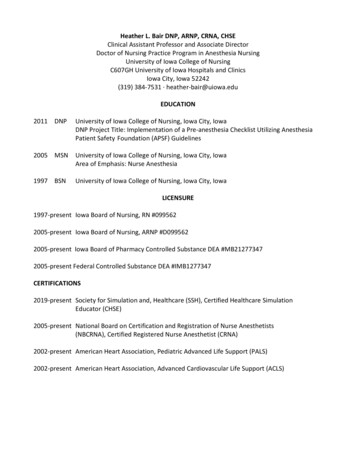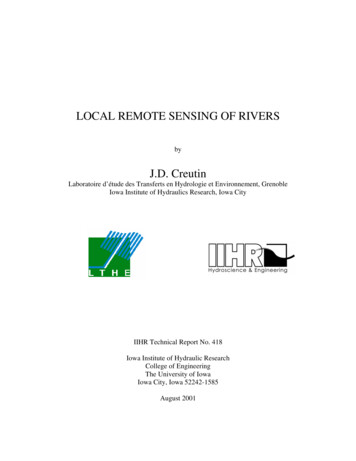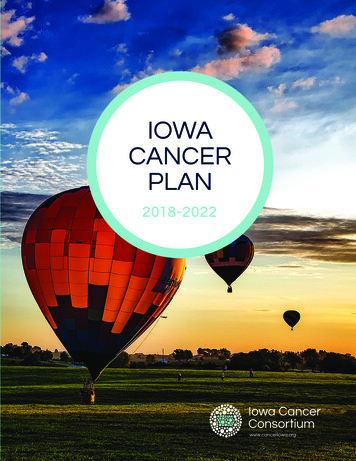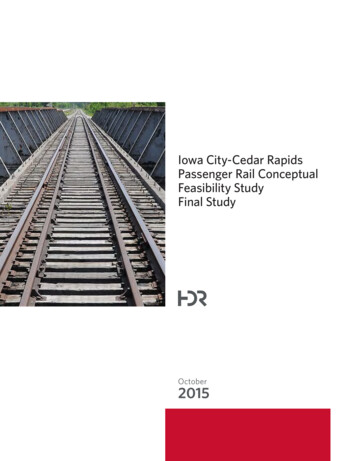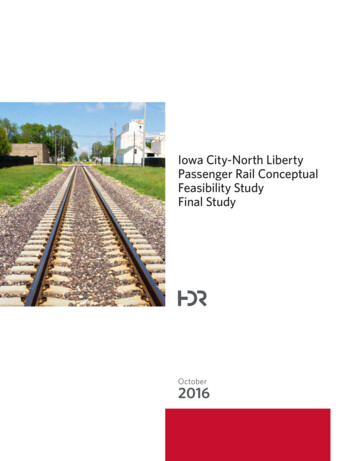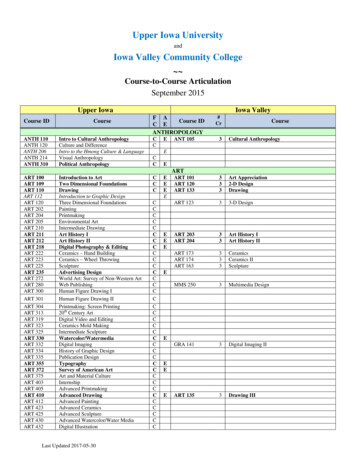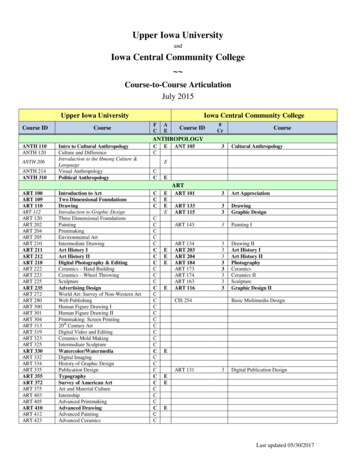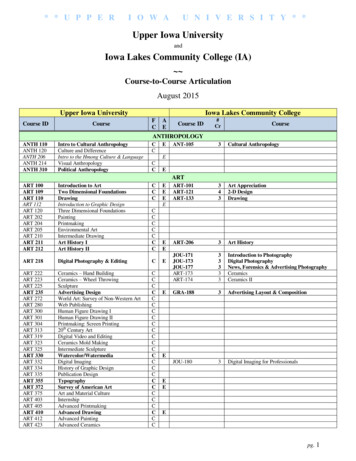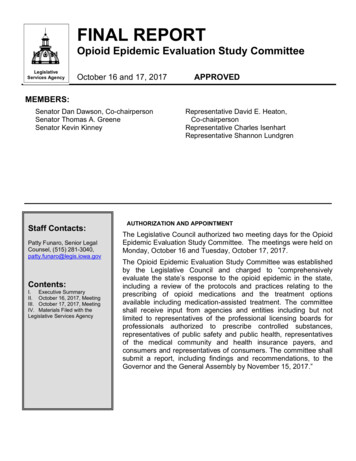
Transcription
FINAL REPORTOpioid Epidemic Evaluation Study CommitteeLegislativeServices AgencyOctober 16 and 17, 2017APPROVEDMEMBERS:Senator Dan Dawson, Co-chairpersonSenator Thomas A. GreeneSenator Kevin KinneyStaff Contacts:Patty Funaro, Senior LegalCounsel, (515) 281-3040,patty.funaro@legis.iowa.govContents:I. Executive SummaryII. October 16, 2017, MeetingIII. October 17, 2017, MeetingIV. Materials Filed with theLegislative Services AgencyRepresentative David E. Heaton,Co-chairpersonRepresentative Charles IsenhartRepresentative Shannon LundgrenAUTHORIZATION AND APPOINTMENTThe Legislative Council authorized two meeting days for the OpioidEpidemic Evaluation Study Committee. The meetings were held onMonday, October 16 and Tuesday, October 17, 2017.The Opioid Epidemic Evaluation Study Committee was establishedby the Legislative Council and charged to “comprehensivelyevaluate the state’s response to the opioid epidemic in the state,including a review of the protocols and practices relating to theprescribing of opioid medications and the treatment optionsavailable including medication-assisted treatment. The committeeshall receive input from agencies and entities including but notlimited to representatives of the professional licensing boards forprofessionals authorized to prescribe controlled substances,representatives of public safety and public health, representativesof the medical community and health insurance payers, andconsumers and representatives of consumers. The committee shallsubmit a report, including findings and recommendations, to theGovernor and the General Assembly by November 15, 2017.”
Opioid Epidemic Evaluation Study CommitteeAPPROVEDI.A.Executive SummaryCharge of the Opioid Epidemic Evaluation Study CommitteeThe Opioid Epidemic Evaluation Study Committee was established by the Legislative Council andcharged to “comprehensively evaluate the state’s response to the opioid epidemic in the state,including a review of the protocols and practices relating to the prescribing of opioid medicationsand the treatment options available including medication-assisted treatment. The committee shallreceive input from agencies and entities including but not limited to representatives of theprofessional licensing boards for professionals authorized to prescribe controlled substances,representatives of public safety and public health, representatives of the medical community andhealth insurance payers, and consumers and representatives of consumers. The committee shallsubmit a report, including findings and recommendations, to the Governor and the GeneralAssembly by November 15, 2017.”B.Meetings ApprovedThe Legislative Council authorized two meeting days for the Opioid Epidemic Evaluation StudyCommittee. The meetings were held on Monday, October 16, and Tuesday, October 17, 2017.C.October 16, 2017, Meeting1.Meeting OverviewOn the first meeting day, the Opioid Epidemic Evaluation Study Committee organizedand elected Temporary Co-chairpersons Senator Dan Dawson and RepresentativeDavid E. Heaton as Permanent Co-chairpersons. The committee approved theproposed rules as distributed. The primary focus of the meeting was to receiveinformation from national and state perspectives, as well as the perspectives of healthprovider licensing boards and associations, treatment professionals, and managed careorganizations. Presentations were provided by representatives of the NationalConference of State Legislatures, the University of Iowa Injury Prevention ResearchCenter, the Iowa Board of Nursing, the Iowa Board of Medicine, the Iowa Dental Board,the Iowa Board of Pharmacy, Mercy Turning Point Treatment Center, the AreaSubstance Abuse Council, United Community Services Healthcare, Prelude BehavioralServices, Anthem Insurance Companies, Inc., UnitedHealthcare, AmeriHealth CaritasIowa, Inc., the Iowa Physical Therapy Association, and the Iowa Chiropractic Society.The committee also received public comment.2.National Conference of State Legislatures (NCSL)a. Overview of State PoliciesMs. Karmen Hanson, Program Director, Health Program, NCSL provided anoverview of state policy actions regarding the opioid epidemic across manysectors, including strategies relating to the four pillars of prevention, intervention,treatment, and recovery.Page 2October 16 and 17, 2017
Opioid Epidemic Evaluation Study CommitteeAPPROVED(1) PreventionPrevention activities in the states include the various approaches toPrescription Drug Monitoring Programs (PDMPs) or PrescriptionMonitoring Programs (PMPs) as well as other prevention efforts includingprescription limits and the use of the 2016 Centers for Disease Controland Prevention of the United States Department of Health and HumanServices (CDC) voluntary guidelines for prescribing opioids for chronicpain, excluding active cancer treatment, palliative care, and end-of-lifecare.(2) Intervention or RescueIntervention or rescue activities include syringe services or needleexchange programs, access to opioid reversal drugs such as naloxoneand Narcan, and Good Samaritan laws.(3) TreatmentTreatment activities in the states focus on Medication AssistedTreatment (MAT). Hurdles to treatment include lack of coverage by allpayers and limitations on treatment including fail-first policies, variationsin Medicaid fee-for-service payment and lack of coverage for residentialtreatment, variations in what constitutes comparable coverage, andcoordination of the vast numbers of stakeholders involved includingconsumers, treatment providers, insurers, and state and federal officials.(4) Road to Recovery Through TreatmentRecovery activities include the use of screening tools by primary careproviders and therapists to determine the need for treatment. There islimited access to treatment, including a shortage of detox and treatmentbeds, as well as a lack of providers in both urban and rural settings.Legislative policies may be used to increase the range of providersauthorized to prescribe MAT medications. There is a growing need forsober living and long-term recovery resources as more people workthrough treatment to the recovery stage.b.c.Policy Intersection with Many SectorsMs. Hanson provided contact information for other NCSL staff who cover the areasof criminal justice and human services since the opioid epidemic necessitatesmany policy sectors collaboratively addressing the issue. NCSL is also availableto discuss technical assistance options.Key Questions to Ask When Developing PolicyMs. Hanson suggested key questions to ask in developing policy:(1) What does the data show in Iowa, what are the biggest issues for Iowa,and where do gaps exist? Ask state agencies for data to determine theOctober 16 and 17, 2017Page 3
Opioid Epidemic Evaluation Study CommitteeAPPROVEDbest approach. National survey data is also available through the CDC,the National Institutes of Health (NIH) and the Substance Abuse andMental Health Services Administration (SAMHSA) of the United StatesDepartment of Health and Human Services.(2) What recent action has been taken by the state and what are the federalfunding opportunities?(3) What new strategies may be needed and are appropriate for Iowa?(4) What agencies and stakeholders need to be at the table?3.The University of Iowa Injury Prevention Research Center (IPRC)a. OverviewDr. Carri Casteel, Associate Director, and Ms. Ann Saba, Communications andResearch Coordinator, IPRC, provided an Iowa perspective on opioid misuse andtreatment. The IPRC is housed in the University of Iowa College of Public Healthand has been funded by the CDC as one of 10 such centers in the United Statessince 1991 to conduct outreach, research, and training relating to the prevention ofviolence and injuries. One area of IPRC’s expertise is prescription opioidoverdose.b. Stakeholder Council — RecommendationsThe IPRC received funding from the CDC for the period January through June2017, to develop a state-specific stakeholder council to identify policy and programpriorities to address prescription opioid concerns; to identify next steps inaddressing priorities; and to identify ways to reach policymakers and otherstakeholders with priority recommendations.The council discussedrecommendations developed by the Johns Hopkins Center for Injury Researchbased on evidence-based strategies for reducing the opioid epidemic in eight topicareas: prescribing guidelines; the PDMP; pharmacy benefit managers andpharmacies; engineering strategies; surveillance; overdose prevention and harmreduction; addiction treatment; and community-based prevention strategies. The38-member council met and identified five priorities and actionable program andpolicy steps. The recommendations of the council included training physicians inpain management and opioid prescribing in medical school; educatingpractitioners to recognize patients at high risk for opioid misuse and overdose;reducing barriers to using the Iowa PMP; strengthening surveillance; and ensuringMedicaid and other health plan coverage of MAT and behavioral therapy.4.Professional Licensing Boards — Iowa Board of Nursing, Iowa Board ofMedicine, Iowa Dental Board, Iowa Board of Pharmacya. Iowa Board of NursingMs. Kathy Weinberg, Executive Director, Iowa Board of Nursing, provided anoverview of the initiatives the board is taking to address the opioid epidemicincluding disseminating the “Safe Prescribing of Opioids for Pain, and Reduction ofOpioid Misuse” E-Blast series; launching a new website dedicated to opioidPage 4October 16 and 17, 2017
Opioid Epidemic Evaluation Study CommitteeAPPROVEDb.c.d.5.prescribing and the resources available; updating the Advanced Registered NursePractitioner (ARNP) rules concerning standards of practice for controlledsubstances; and establishing a program to assist nurses with impairments.Iowa Board of MedicineMr. Mark Bowden, Executive Director, Iowa Board of Medicine, spoke about theboard’s activities and rules. He provided a historical perspective of the board’swork and practitioner education, guidance, and directives relating to painmanagement dating back to 1997; and reviewed a summary of the approximately200 opioid-related complaints relating to appropriate prescribing and painmanagement that the board has dealt with since 2011.Iowa Dental BoardMr. Phil McCollum, Associate Director, Iowa Dental Board, provided an overviewof the board’s activities including the board’s review of the use of the PMP bylicensees, the board’s recently created opioid task force to develop guidelines anddrug alternatives for prescribing specific to acute pain, and plans with theUniversity of Iowa College of Dentistry to host a one-day symposium and developcontinuing education programming.Iowa Board of PharmacyMr. Andrew Funk, Executive Director, Iowa Board of Pharmacy, stated the board istasked with the distribution of legal prescription drugs through prescribing,dispensing, manufacturing, wholesaling, and retailing, as well as, since 2009,managing the state PMP. Mr. Funk reviewed issues with the current PMP, therecently released Request for Proposal (RFP) to update the PMP, proposed rulesto allow for partial filling of prescriptions for Schedule II controlled substancesunder the Federal Comprehensive Addiction and Recovery Act (CARA), theboard’s operation of a medication disposal program, and education and outreachefforts.Treatment Providersa. Mercy Turning Point Treatment Center (MTP)Ms. Malissa Sprenger, Coordinator, Mercy Turning Point Treatment Center,located at Mercy Medical Center in Dubuque, provided an overview of activities inthe Dubuque area including the services provided by MTP and establishment of anopioid response team.Ms. Sprenger provided a listing of recommendations relating to advancingresponsible, evidence-based prescribing practices; increasing access to opioidoverdose reversal drugs and advancing protections including Good Samaritanlaws; providing adequate and meaningful health care coverage for treatmentincluding for non-drug treatment alternatives; requiring participation bypractitioners in the PMP; increasing treatment capacity including throughestablishment of a public long-term treatment facility for those with complex needs;expanding the health workforce to include expertise in addiction, prevention,October 16 and 17, 2017Page 5
Opioid Epidemic Evaluation Study CommitteeAPPROVEDtreatment, and rehabilitation; providing and supporting resources for the fullspectrum of providers necessary for a whole-person approach to an individual’sphysical, behavioral, and social supports; broadening community awareness,engagement, and education across all stakeholders to break down barriers andreduce stigma; and enhancing data collection and data sharing as well ascommunication, transparency, and accountability among all stakeholders.b.c.d.Page 6Area Substance Abuse Council (ASAC)Ms. Barb Gay, Executive Director, ASAC, located in Cedar Rapids, provided anoverview of ASAC’s services in a five-county area that include prevention,treatment, and recovery services. ASAC provides MAT, which allows the brainsufficient time to heal over a longer treatment period, resulting in successfulrecovery. ASAC uses Vivitrol in the injection form, but there are concerns withreimbursement in the future as health care coverage for Vivitrol changes from apharmacy benefit to a medical benefit. There are also issues with the limitednumber of prescribers for MAT medications, a great part of which is due to thestigma attached to treating people with addictions. ASAC has developed a shareddatabase to link patients to a variety of support services.United Community Services Healthcare (UCS)Mr. Mike Polich, Chief Executive Officer, United Community Services Healthcare,provided a historical perspective on substance use disorder treatment in the DesMoines area, and described the evolution of UCS and the services UCS provides.UCS is a certified Opioid Treatment Program (OTP) providing MAT services.OTPs are accredited by a SAMHSA-approved accrediting body and are requiredby federal law to provide medical, counseling, vocational, educational, and otherassessment and treatment services, in addition to prescribed medications. OTPsrequire a great deal of structure and cost approximately 1 million to establish.UCS is hoping to leverage its OTP license to establish medication units in remoteareas using telehealth to prescribe. Medication units cost approximately 24,000to establish and allow licensed practitioners or community pharmacists to dispenseor administer an opioid agonist treatment medication or collect samples for drugtesting or analysis. There is uncertainty about how third-party payers will bill theOTP for medications provided through a medication unit, and the communities inwhich medication units are established will have to be educated about stigma andopioid addiction.Prelude Behavioral Services (PBS)Mr. Ron Berg, Director and Chief Executive Officer, Prelude Behavioral Services,described PBS as providing residential and outpatient services, transitionalhousing, and other services in Des Moines and Iowa City for those with gambling,mental health, and substance use disorder issues. PBS serves all 99 counties,and both urban and rural areas. PBS has 99 beds for residential treatment andhalfway services, with an average waiting period of 9.5 days for admission totreatment. PBS is beginning to provide MAT services and is completing aOctober 16 and 17, 2017
Opioid Epidemic Evaluation Study CommitteeAPPROVEDcommunity needs assessment to participate in the SAMHSA State TargetedResponse grant received by DPH in order to act as an opioid-informed communityin addressing opioid misuse. MAT services need to be more accessible and inorder to maintain and sustain adequate substance use disorder resources in thefuture, there needs to be a foundation in a solid business model andreimbursement rates must be sufficient. The response to the opioid crisis, as withany other substance abuse crisis, is hampered by the stigma still associated withdrug and alcohol abuse. All stakeholders have a role in improving collaboration toaddress the epidemic.6.Managed Care Organizations (MCOs)a. Anthem Insurance Companies, Inc. (Anthem)(1) Mr. Eric Bailly, Business Solutions Director, Anthem InsuranceCompanies, Inc., spoke about Anthem’s efforts at the national level toaddress the opioid epidemic. Anthem made a commitment to reduce thelevels of prescribed opioids within its network of providers by 35 percentby the end of 2019, and to double the number of consumers who receivebehavioral health treatment as part of MAT for opioid addiction.Anthem’s comprehensive strategy includes addressing the areas ofprevention, treatment and recovery, and deterrence.(2) Prevention efforts include promoting coordination of care and ensuringappropriate medication access by placing limitations on or requiring priorauthorization for certain opioid prescriptions; covering MAT; introducing apharmacy home program; and utilizing a controlled substance usemonitoring program. Iowa does not allow for point-of-sale edits, butAnthem uses this approach in other markets.(3) Treatment and recovery efforts include minimizing the risks and enablingearlier identification of misuse and abuse by providing care managementsupport; improving MAT access in rural areas through primary careprovider recruitment; providing peer support recovery services;expanding care and treatment options through telehealth; and increasingprovider and vendor collaboration. Anthem is also providing access toevidence-based online consumer tools and offering coverage fornonpharmacologic approaches to pain management including physicaltherapy, osteopathic manipulation, pain management programs, andcognitive behavioral therapy. Anthem has established collaborativerelationships with treatment providers including the Betty Ford Centerand Bright Heart Health, which is helping Anthem to reach rural areasthrough the use of telehealth.(4) Deterrence efforts include leveraging data mining and analyticcapabilities by reviewing high volume pharmacies; partnering with lawenforcement to monitor claims for potential fraudulent or abusivebehavior; monitoring potential doctor shopping, investigating “pill mills,”October 16 and 17, 2017Page 7
Opioid Epidemic Evaluation Study CommitteeAPPROVEDb.c.Page 8and providing provider education. Anthem sends cautionary letters toprescribers who are falling outside the norm of established prescribingpractices and also notifies prescribers if they are prescribing drugs thathave potential negative interactions.UnitedHealthcare (UHC)(1) Dr. KellyAnn Light-McGroary, Chief Medical Officer, UnitedHealthcare,said that for the next two years, UHC’s goal is to use a multiprongedapproach to reach at least 75 percent compliance with the CDC opioidprescribing guidelines for providers; to increase participation in MAT forthose patients needing MAT by 50 percent; and to increase staff,customer, provider, and member education in attacking the opioidproblem. UHC’s comprehensive strategy includes addressing the areasof prevention, treatment, recovery, and harm reduction.(2) The objectives of the prevention strategy are to increase understandingof the epidemic among staff, customers, providers, and members and toimprove prescriber adherence to the CDC guidelines. UHC is reviewingmember opioid use on the PMP, compiling prescriber outlier reports, andfollowing up with primary care providers and behavioral health providers.(3) The objectives of the treatment strategy include increasing MATcapacity, increasing the number of members who receive MAT, andsupporting individuals seeking treatment on their journey to recovery.There are many opportunities for integration of physical and behavioralhealth care to address the medical, behavioral, and social needs of thewhole person. UHC is also expanding its MAT network and reducingbarriers to use of MAT.(4) The objectives of the recovery strategy are to utilize person-centered andevidence-based approaches to recovery and to reduce social barriersthat impede recovery, health, and well-being.UHC is usinginterdisciplinary care teams to work around barriers such astransportation, housing, and employment to ensure that those inrecovery are successful.(5) The objectives of harm reduction are to reduce overdose deaths and toincrease the safe use, storage, and disposal of opioid prescriptions.AmeriHealth Caritas Iowa, Inc. (AmeriHealth)(1) Dr. Victoria Sharp, Chief Medical Officer, AmeriHealth Caritas Iowa, Inc.,spoke about integrative models for chronic pain management andaddiction treatment. AmeriHealth’s three areas of activity focus onproactive initiatives to prevent opioid misuse; treatment options andchallenges in Iowa; and the use of overdose reversal drugs.(2) In the area of proactive initiatives to prevent opioid misuse, AmeriHealthuses a multifaceted approach including identifying at-risk members;October 16 and 17, 2017
Opioid Epidemic Evaluation Study CommitteeAPPROVEDmonitoring for overprescribing and reaching out to providers to discusscases; offering provider education on non-opioid pain managementoptions such as physical therapy, occupational therapy, and chiropracticservices; using pharmacist telephonic outreach to addressoverutilization; using a pharmacy lock-in program that requires a memberto use only one pharmacy; including member education in its newsletter;and using a holistic approach to integrating care management bymerging behavioral health support with physical treatment. Specifically,AmeriHealth tracks narcotic prescriptions to pregnant members, providesoutreach, and engages these women in high-risk pregnancy caremanagement; and works with substance abuse treatment centersthroughout the state to identify places that can accommodate pregnantmembers and women with infants throughout treatment.(3) In the area of treatment options and challenges in Iowa, the limitedaccess to treatment has made it difficult for AmeriHealth’s Medicaidmembers to get the treatment they need. MAT is valuable during theimmediate withdrawal process as well as during ongoing treatment, andhas a 70 percent success rate, but there is a lack of MAT resources.While AmeriHealth Medicaid members have access to Vivitrol in the dailyoral form, the injectable form is preferred for compliance. For Medicaidmembers, the injectable form of Vivitrol can only be administered in aphysician’s office, which is costly and time intensive for physicians,thereby limiting access to injectable Vivitrol for Medicaid members.(4) In the area of use of overdose reversal drugs, while DPH and the Boardof Pharmacy have made overdose reversal drugs such as naloxoneavailable without a prescription, Iowa Medicaid members are not able toparticipate due to regulatory limitations.(5) Dr. Sharp recommended increasing access to Vivitrol and MAT byworking with DHS to explore options for delivering the injectable form ofVivitrol; working with DHS to allow Medicaid members to participate inthe standing order program to ensure access to naloxone; continuing amultifaceted approach by involving providers, members, families, lawenforcement, and others to provide a more accessible, efficient, andproductive addiction treatment environment; and expanding the availableeducation resources for prescribers and other practitioners on evidencebased pain management treatment and substance use disorders.7.Iowa Physical Therapy Association (IPTA)Mr. Matt Bravard, Iowa Physical Therapy Association, described the “#ChoosePT”campaign that the IPTA launched following the release of the 2016 CDC guidelineswhich included recommendations for safer alternatives for management of acute andchronic pain. Since then, IPTA has been involved in other efforts to increase publicawareness, to provide patient education regarding options to address and avoid pain,October 16 and 17, 2017Page 9
Opioid Epidemic Evaluation Study CommitteeAPPROVEDand to educate the public. Physical therapy is an evidence-based, high-qualityapproach to treating pain. Third-party payers generally impose limitations on thenumber of weeks or visits covered, and utilization of physical therapy does depend on apatient’s goals and the experience of the patient’s physician with physical therapy.8.Iowa Chiropractic SocietyDr. Wes Nyberg, President, Iowa Chiropractic Society, noted that chiropractic careoffers an alternative approach to pain management, without the use of prescribedmedications. Instead, chiropractic care addresses neuro-musculoskeletal conditionsthrough adjustment. Chiropractic is a drug-free, noninvasive, and cost-effectivealternative to opioid drugs for pain management. Third-party payers do sometimesrestrict patient access to chiropractic care by requiring prior authorization from amedical doctor, reducing the number of visits, or decreasing overall reimbursement.9.Public Commenta. Dr. Janie Hendricks, Past President, Polk County Medical Society, speaking as apatient advocate, cautioned that there should not be a one-size-fits-all approachfrom insurance companies regarding pain management, the prescribing ofmedications, and the treatment of opioid abuse. Physicians should have thelatitude to determine the best course of treatment for their patients, becausedoctors, not insurance companies, know their patients and how to treat their pain.Dr. Hendricks said it is the role of the primary care physician to provide long-termmonitoring of a patient to evaluate ongoing use of opioids to address pain.b. Ms. Deborah Thompson, policy advisor and legislative liaison for DPH, spoke inher capacity as an individual to provide the story of her husband, Joe Thompson,who died of an accidental overdose in September 2016, leaving her and their oneyear-old son, Lincoln, behind. Joe had a good childhood and was successfulthroughout his lifetime; he had a strong, supportive, and loving family; they had asuccessful marriage; and she had a stable income and good health insurancecoverage. However, Joe was overprescribed opioids after a serious car accidentin 2004, and this started them on a 13-year journey through the disease to whichhe ultimately succumbed. Ms. Thompson described Joe’s treatment history, notedthat the abstinence approach did not work for Joe and his opioid addiction, andcautioned that not all treatment facilities are equipped to provide treatment foropioid addiction. Ms. Thompson said there is a stigma associated with opioidaddiction both from society toward the person with the addiction and on the part ofthe person with the addiction who feels they do not belong in the addictioncommunity. Opioid addiction is a disease like any other that needs to beaddressed and overcome. Ms. Thompson shared their story because she wantedthe committee members to ask questions and to continue to use her as aresource. She noted that she is proud of her colleagues at DPH and is sure thestate can address the opioid epidemic using good public health preventionstrategies.Page 10October 16 and 17, 2017
Opioid Epidemic Evaluation Study CommitteeAPPROVEDD.October 17, 2017, Meeting1.Meeting OverviewOn the second meeting day, the focus of the committee was law enforcement andpublic safety, harm reduction, medical education, private health care coverage, and theactivities of the DPH. Presentations were provided by representatives of theDepartment of Justice; the Iowa Harm Reduction Coalition; the Bureau of HIV, STD,and Hepatitis of the Department of Public Health; the Department of Public Safety; theUniversity of Iowa Carver College of Medicine; Des Moines University College ofOsteopathic Medicine; the Cedar Rapids Police Department/Eastern Iowa HeroinCoalition; Wellmark Blue Cross and Blue Shield; and the DPH. The study committeealso received public comment and discussed next steps.2.Department of JusticeMr. Nathan Blake, Deputy Attorney General for Policy, Department of Justice,discussed opioid use and enforcement in Iowa. He noted that there is not good dataavailable to know about all those addicted to opioids who are not seeking treatment orhave not died. He reviewed the ongoing multistate opioid investigation involving 40states and the District of Columbia against five pharmaceutical manufacturers andthree distributors. Potential claims include the safety and effectiveness of long-termuse; false claims of low addiction risk and pseudo-addiction; and false claims on risksof overdoses. Other city, county, and state lawsuits are also pending. Iowa is a leaderin the multistate action, but is also developing research for a strong state case as anoption for a quicker resolution. Without advocating for any one option, Mr. Blake listedpotential options for the state to address the opioid epidemic including prescriptionlimits; PMP requirements and the checking of IDs before dispensing prescriptions ofcontrolled substances; making opioid reversal drugs more available and affordable; andthe provision of Good Samaritan and Overdose Immunity laws, syringe servicesprograms, prescription drug take-back programs, mandated provider training onaddiction risks, and MAT funding.3.Iowa Harm Reduction Coalition (IHRC) and Bureau of HIV, STD, and Hepatitis(DPH)Ms. Sarah Ziegenhorn, Executive Director and Co-founder, and Mr. Jonathan Birdsall,Legislative Advocacy Director, Iowa Harm Reduction Coalition; and Mr. Randy Mayer,Bureau Chief, Bureau of HIV, STD, and Hepatitis, DPH, described the incidences ofHIV and Hepatitis C Virus (HCV), which is an increasing but separate epidemicexacerbated by the needle use associated with the opioid epidemic. They describedthe HIV and HCV epidemic and proposed the establishment of a syringe servicesprogram (SSP) as a means of addressing this epidemic. The presenters described thebimodal age distribution of diagnoses of HCV. Those in the 46-to-70-year-old agerange at the time they are diagnosed were infected many years ago, and while at ris
Dr. Carri Casteel, Associate Director, and Ms. Ann Saba, Communications and Research Coordinator, IPRC, provided an Iowa perspective on opioid misuse and treatment. The IPRC is housed in the University of Iowa College of Public Health and has been funded by the CDC as one of 10such centers in the United States


